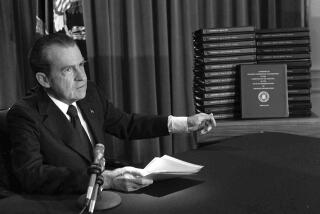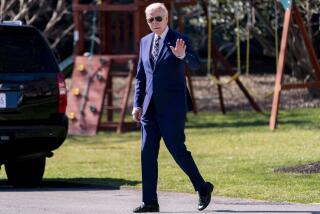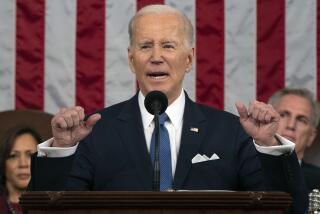Administration to Unveil $1.4-Trillion Budget : Deficit: Program seeks to honor accord hammered out with Congress last fall. It offers little new military or domestic spending.
WASHINGTON — Faced with the enormous costs of both war and recession, the Bush Administration on Monday will unveil a $1.4-trillion federal budget for 1992 that will mark the beginning of yet another attempt by Washington to live within its means.
Despite the huge price tag, the 1992 budget represents the White House’s first crack at meeting the spending limitations hammered out during last fall’s rancorous budget talks, which set deficit-reduction targets of $495 billion over five years.
The commitment to honor last year’s agreement has been made more difficult by the recession, which will certainly push the deficit to a new record of more than $300 billion in 1991, far above the levels forecast when the five-year budget deal was approved last fall.
The Administration believes that the deficit will shrink only slightly to $281 billion in the 1992 fiscal year that begins next Oct. 1, while overall federal spending is expected to rise 1% to 2%, or less than the anticipated rate of inflation.
In order to meet the guidelines of the deficit accord, which require any new spending to be offset by cuts elsewhere, the Administration will offer little in the way of new domestic or military programs for next year.
To stay within spending targets, the White House will need to employ some smoke and mirrors. As part of last fall’s budget accord, Congress and the Administration agreed to exclude from their deficit calculations the government’s biggest and most controversial programs, notably the Persian Gulf War and the bailout of the nation’s savings and loans.
While the war is now costing between $500 million and $1 billion per day, all expenditures for Operation Desert Storm, along with the earlier costs of Operation Desert Shield, have been excluded from the Pentagon budget that will be presented to Congress this week. At least a portion of those costs are being offset by America’s allies, who have pledged to cover about $40 billion of the military costs of the first three months of the war.
Still, only a fraction of those pledges--about $5 billion--has actually materialized in the form of hard cash. So, with some estimates of the total cost of the first three months of the war running as high as $60 billion, it is clear that the Gulf crisis will sharply inflate the real deficit--whether those figures are included in the official budget or not.
And if the spiraling costs of the savings and loan debacle also were included in the official budget, this year’s deficit would easily break the $400-billion figure.
Still, the budget package will make at least a few genuine cuts. At the Pentagon, for example, it will provide the first indication of how the Administration hopes to shape post-Cold War defense spending, despite the sudden boom in military expenditures caused by the war. The 1992 defense budget is expected to call for spending authority of $278.3 billion and actual outlays of $283 billion--representing a 3.3% decline in outlays after inflation.
The budget calls for sharp cuts in military personnel and the cancellation of two nuclear missile programs. While it also notes that the Administration hopes to scale back and refocus the controversial “Star Wars” anti-missile defense program, that policy change will not have any significant impact on the 1992 budget.
The military budget sticks to the defense spending guidelines imposed by last fall’s deficit-reduction agreement, which requires that the Pentagon cut back by $243 billion over five years.
The Washington Post reported Friday that, faced with a wartime recession and a rising deficit, President Bush would propose greater savings in domestic benefit programs.
Citing congressional and Administration sources, the Post said Bush would ask Congress for savings of more than $50 billion over five years in Medicare, farm programs, student aid and child nutrition.
One area that will see increased spending will be the war on drugs, where Bush has proposed an 11% increase in funding, rising to $11.7 billion. That includes a $100-million proposal to expand drug treatment facilities around the nation.
But the budget is short on new ideas in other areas. In fact, one of the only new provisions in the package, the transfer of $15 billion in funding to state governments, really has its roots in an old program--1970s-style revenue sharing.
Administration officials insisted last week that the new block grant proposal is a dramatic departure from the unpopular revenue sharing programs introduced by the Richard M. Nixon Administration. The goal of the new plan, they said, is to provide state officials with much greater flexibility in spending federal funds.
But the nation’s governors, meeting in Washington this weekend, were skeptical, saying that the proposal was too small to provide any real relief for states now facing severe financial pressures.
“Pennsylvania could use all of the $15 billion the President talked about sending back to the states” just to fund one medical assistance program, complained Pennsylvania Gov. Robert P. Casey.
More to Read
Get the L.A. Times Politics newsletter
Deeply reported insights into legislation, politics and policy from Sacramento, Washington and beyond. In your inbox three times per week.
You may occasionally receive promotional content from the Los Angeles Times.










